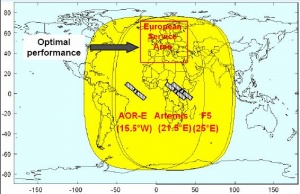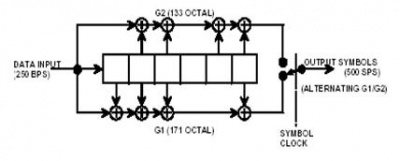If you wish to contribute or participate in the discussions about articles you are invited to contact the Editor
Category:EGNOS Signal Structure
| EGNOS | |
|---|---|
| Title | EGNOS Signal Structure |
| Author(s) | GMV. |
| Level | Basic |
| Year of Publication | 2011 |
The European Geostationary Navigation Overlay Service (EGNOS) improves the open public service offered by the Global Positioning System
(GPS). Currently, EGNOS augments the GPS civilian signal L1, transmitted at frequency 1575.42 MHz. In particular, EGNOS broadcasts differential
corrections and integrity information on the GPS measurements via several geostationary satellites centered on Europe, via an extended network
of ground stations defined in the EGNOS Architecture.
EGNOS SIS Interface Characteristics
The EGNOS Signal In Space format is compliant with the ICAO SARPs for SBAS[1] as stated in the EGNOS Open Service Service Definition Document.[2] The EGNOS SIS interface characteristics comprise carrier and modulation radio frequency, message structure, protocol and content of the EGNOS message (detailed in the EGNOS Message Format definition).
The EGNOS signal is broadcast by two Inmarsat-3 satellites (one positioned east of the Atlantic, and the other above Africa) and by ESA’s Artemis satellite, which is also above Africa. These three satellites’ orbits are in the equatorial plane, at three different longitudes, with each able to broadcast EGNOS services across the whole ECAC area.[3]
Unlike the GPS and GLONASS satellites, these three space platforms carry no signal generators. They are fitted with a transponder which does nothing more than relay the signal processed on the ground and sent into space.
The elements of the EGNOS satellite infrastructure deployed and their orbital location are detailed in the following table.
| Satellite | PRN | ID(NMEA) | Position |
|---|---|---|---|
| ARTEMIS | 124 | 37 | 21.5E |
| INMARSAT AOR-E | 120 | 33 | 15.5W |
| INMARSAT IOR-W | 126 | 39 | 25E |
The PRN, represents the 1023-bit Pseudorandom code employed in the generation of the SIS corresponding to each geostationary satellite. Besides, the footprint of the 3 Geostationary satellites can be observed in the illustration.
EGNOS SIS RF Characteristics
The EGNOS GEO satellites transmit right-hand circularly polarised (RHCP) signals in the L band at 1575.42 MHz (L1). The broadcast signal is a combination of a 1023-bit PRN navigation code of the GPS family and a 250 bits per second navigation data message carrying the corrections and integrity data elaborated by the EGNOS ground segment.
This raw navigation message is ½ convolutional encoded with Forward Error Correcting (FEC) Code resulting in a 500 symbol/second EGNOS data stream.
This data stream is added modulo-2 to a 1023-bit PRN code, which will then be biphase shift-keyed (BPSK) modulated onto the L1 carrier frequency at a rate of 1.023 Mega-chips/second (Mcps). [4]
The EGNOS SIS is such that, at all unobstructed locations near ground level from which the satellite is observed at an elevation angle of 5 degrees or higher, the level of the received RF signal at the output of a 3dBi linearly polarised antenna is within the range of –161 dBW to –153 dBW for all antenna orientations orthogonal to the direction of propagation. Besides, spurious transmissions will be at least 40dB below unmodulated carrier power over all frequencies.
It is intended that future geostationary satellites used for EGNOS replenishment will broadcast higher minimum signal power levels in order to improve the acquisition and tracking performance of the user receiver.
The most relevant EGNOS signal characteristics are detailed hereafter:[4]
- Carrier Phase Noise: The phase noise spectral density of the unmodulated carrier is such that a phase locked loop of 10Hz one-sided noise bandwidth is able to track the carrier to an accuracy of 0.1 radians rms.
- Signal Spectrum: The broadcast signal is at GPS L1 frequency of 1575.42 MHz. At least 95% of the broadcast power is contained within a +/- 12MHz band centered at the L1 frequency. The bandwidth of the signal transmitted by an EGNOS satellite is at least 2.2MHz.
- Doppler Shift: The Doppler shift, as perceived by a stationary user, on the signal broadcast by EGNOS GEOs is less than 40 meters per second (≈210 Hz at L1) in the worst case (at the end of life of the GEOs). The Doppler shift is due to the relative motion of the GEO.
- Carrier Frequency Stability: The short term stability of the carrier frequency (square root of the Allan Variance) at the input of the user´s receiver antenna will be better than 5x10-11 over 1 to 10 seconds, excluding the effects of the ionosphere and Doppler.
- Polarization: The broadcast signal is right-handed circularly polarized. The ellipticity will be no worse than 2 dB for the angular range of ±9.1o from boresight.
- Correlation Loss: Correlation loss is defined as the ratio of output powers from a perfect correlator for two cases: 1) the actual receiver EGNOS signal correlated against a perfect unfiltered PN reference, or 2) a perfect unfiltered PN signal normalized to the same total power as the EGNOS signal in case 1, correlated against a perfect unfiltered PN reference. The correlation loss resulting from modulation imperfections and filtering inside the EGNOS satellite payload is less than 1 dB.
GPS/SBAS Signal Generators
A range of signal generators were developed in the GNSS Industry as a means to provide flexible platforms for the testing and signal evaluation.
These products allow to select specific navigation satellite systems, to define influencing error sources, to choose signal frequency and modulations schemes as well as the RF Front end and filter characteristics.
These generators are easy to integrate on user test environments and their purpose is to evaluate acquisition and tracking algorithms or receiver HW, to design multipath and interference mitigation strategies.
Some of the most representative product manufacturers are Spirent[5] and Novatel.[6]
Notes
References
- ^ SARPS Amendment 77, Annex 10 to the Convention on International Civil Aviation, Aeronautical Telecommunications: International Standards and Recommended Practices, Volume 1, Radio Navigation Aids, November 2002.
- ^ EGNOS Open Service Definition Document
- ^ EGNOS User Guide for Developers
- ^ a b Minimum Operational Performance Standards for Global Positioning System/Wide Area Augmentation System Airbone Equipment
- ^ Spirent GSS4100 Signal Generator Product Reference Sheet
- ^ Novatel GUS-Type 1 Signal Generation Product Sheet
Pages in category "EGNOS Signal Structure"
This category contains only the following page.


